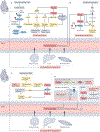Branched-chain amino acids in cardiovascular disease
- PMID: 36064969
- PMCID: PMC10284296
- DOI: 10.1038/s41569-022-00760-3
Branched-chain amino acids in cardiovascular disease
Abstract
Research conducted in the past 15 years has yielded crucial insights that are reshaping our understanding of the systems physiology of branched-chain amino acid (BCAA) metabolism and the molecular mechanisms underlying the close relationship between BCAA homeostasis and cardiovascular health. The rapidly evolving literature paints a complex picture, in which numerous tissue-specific and disease-specific modes of BCAA regulation initiate a diverse set of molecular mechanisms that connect changes in BCAA homeostasis to the pathogenesis of cardiovascular diseases, including myocardial infarction, ischaemia-reperfusion injury, atherosclerosis, hypertension and heart failure. In this Review, we outline the current understanding of the major factors regulating BCAA abundance and metabolic fate, highlight molecular mechanisms connecting impaired BCAA homeostasis to cardiovascular disease, discuss the epidemiological evidence connecting BCAAs with various cardiovascular disease states and identify current knowledge gaps requiring further investigation.
© 2022. Springer Nature Limited.
Conflict of interest statement
Competing interests
The authors declare no competing interests.
Figures


References
Publication types
MeSH terms
Substances
Grants and funding
LinkOut - more resources
Full Text Sources
Medical
Miscellaneous

